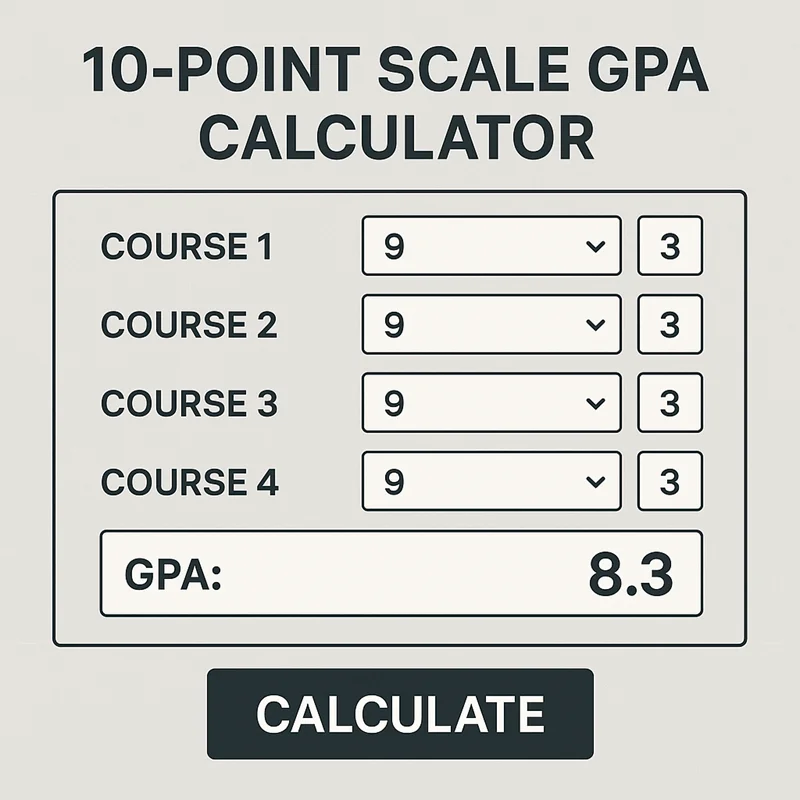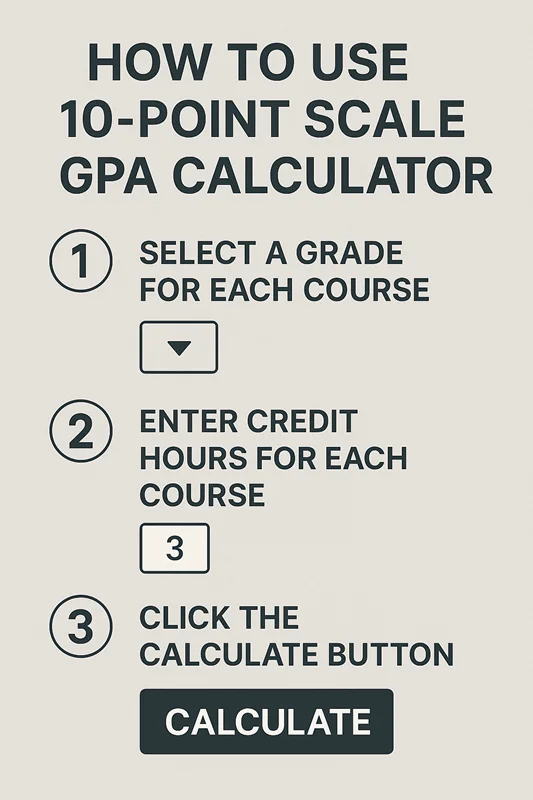| Subject Name | Grade | Credits | Action |
|---|
Calculate your GPA with ease and accuracy
| Subject Name | Grade | Credits | Action |
|---|
Converting your CGPA to GPA can feel overwhelming when applying to universities abroad. Whether you’re targeting American universities or Canadian institutions, understanding how to accurately convert your 10-point scale CGPA to a 4-point GPA is crucial for your application success.
This comprehensive guide provides everything you need: conversion formulas, detailed tables, real examples, and answers to common questions that international students face during their study abroad journey.
The 10-point GPA scale is an academic grading system where the highest achievable grade point is 10.0. This system is predominantly used in Indian universities, engineering colleges, and several institutions across South Asia.
In this system, your CGPA (Cumulative Grade Point Average) represents your overall academic performance across all semesters. A CGPA of 10.0 indicates perfect academic performance, while anything above 7.0 is generally considered good academic standing.
The 4-point GPA system, widely used in the United States and Canada, caps the maximum GPA at 4.0. This fundamental difference creates the need for conversion when applying to international universities.
Key differences include:
Converting your CGPA becomes essential when applying to universities in countries that use different grading systems. Here’s why this conversion matters:
Academic Requirements: Most American, Canadian, and European universities require GPA reporting on their familiar scales. Admission committees need to compare applicants fairly across different educational backgrounds.
WES Evaluation: Organizations like WES (World Education Services) provide official credential evaluations that include GPA conversion. Many universities specifically require WES-evaluated transcripts for international applicants.
Scholarship Applications: Merit-based scholarships often have minimum GPA requirements. Accurate conversion ensures you don’t miss opportunities due to incorrect grade reporting.
Program Eligibility: Graduate programs frequently set GPA thresholds. Understanding your converted GPA helps you target appropriate programs and set realistic expectations.
The most commonly used formula for converting 10-point CGPA to 4-point GPA is:
GPA = (CGPA – 0.75) × 4/9.25
This formula accounts for the different scale ranges and provides a proportional conversion that most universities accept.
Alternative Formula
Some institutions prefer a simpler approach:
GPA = CGPA × 0.4
However, this formula tends to be less accurate for higher CGPA values and may not reflect true academic performance equivalency.
Different universities and evaluation services may use slightly different conversion formulas. Always check with your target institution or use official evaluation services like WES for the most accurate conversion.

Here’s a comprehensive conversion table using the standard formula:
CGPA (10-Point) | GPA (4-Point) | Letter Grade | Academic Standing |
10.0 | 4.00 | A+ | Outstanding |
9.5 | 3.78 | A+ | Excellent |
9.0 | 3.56 | A | Excellent |
8.5 | 3.33 | A- | Very Good |
8.0 | 3.11 | B+ | Good |
7.5 | 2.89 | B+ | Good |
7.0 | 2.67 | B | Satisfactory |
6.5 | 2.44 | B- | Average |
6.0 | 2.22 | C+ | Below Average |
5.5 | 2.00 | C | Poor |
5.0 | 1.78 | C- | Poor |
Understanding the Conversion Results
A CGPA of 8.0 converts to approximately 3.11 GPA, which falls in the “Good” category for most universities. This helps you understand where you stand competitively in international applications.
Step-by-Step Example: Convert Your CGPA to GPA
Let’s work through a practical example to demonstrate the conversion process:
Student Profile: Rajesh has a CGPA of 8.5 from his engineering program and wants to apply for a Master’s program in the US.
Step 1: Identify Your CGPA
Current CGPA: 8.5
Step 2: Apply the Conversion Formula
Using the standard formula: GPA = (CGPA – 0.75) × 4/9.25
Calculation:
Step 3: Round to Appropriate Decimal Places
Final converted GPA: 3.35
Step 4: Verify Against Conversion Table
Cross-checking with our table, 8.5 CGPA corresponds to 3.33 GPA, confirming our calculation is accurate.
This GPA of 3.35 positions Rajesh competitively for many US graduate programs, as it exceeds the typical 3.0 minimum requirement.
A 10-point scale GPA calculator simplifies the conversion process and eliminates calculation errors. These digital tools instantly convert your CGPA to the equivalent 4-point GPA using standardized formulas.
Benefits of Using a GPA Calculator:
How to Use the Calculator:
Most reliable calculators also provide letter grade equivalents and percentile rankings to give you a complete picture of your academic standing.
Different countries and evaluation services have varying approaches to GPA conversion. Here’s what you need to know:
United States (WES Evaluation)
WES uses proprietary conversion scales that may differ from standard formulas. Their evaluations are widely accepted by US universities and provide official documentation of your academic credentials.
WES considers factors like:
Canada
Canadian universities often accept direct CGPA-to-GPA conversions using standard formulas. However, some institutions prefer percentage-based evaluations.
Many Canadian universities consider:
United Kingdom and Europe
UK universities typically work with percentage systems rather than GPA conversions. However, for comparison purposes:
Australia
Australian universities use a Grade Point Average system similar to the US but with different scaling. Many accept standard conversion formulas with institutional verification.
Avoiding these common pitfalls ensures accurate conversion and stronger applications:
Mistake 1: Using Incorrect Formulas
Different conversion formulas exist, and using the wrong one can significantly impact your results. Always verify which formula your target institution prefers or use official evaluation services.
Mistake 2: Rounding Errors
Premature rounding during calculations can accumulate errors. Complete the entire calculation before rounding to the appropriate decimal places (usually two decimal places).
Mistake 3: Ignoring Institution-Specific Requirements
Some universities have their own conversion standards or prefer official evaluations. Research each institution’s specific requirements rather than assuming all accept the same conversion method.
Mistake 4: Converting Individual Semester GPAs Incorrectly
Your overall CGPA should be converted as a whole, not by averaging converted semester GPAs. This maintains the weighted importance of each semester’s credit hours.
Mistake 5: Not Considering Credit Hours
Some conversion methods account for credit hour weightings. Ensure your conversion method aligns with how your target institution evaluates academic performance.

A 7.5 CGPA converts to approximately 2.89 GPA, which meets the minimum requirements for many international programs. While competitive for some institutions, you should research specific program requirements and consider strengthening other application components like test scores and extracurriculars.
UK universities typically work with percentage systems rather than GPA. However, some may request GPA equivalents for comparison purposes. Check with individual institutions about their preferred academic reporting formats.
Most US graduate programs prefer a minimum 3.0 GPA, with competitive programs often expecting 3.5+. A CGPA of 8.5+ (approximately 3.3+ GPA) positions you well for many programs.
WES evaluation provides official, widely-accepted conversions that many universities prefer or require. While self-conversion works for initial assessments, official evaluations carry more weight in actual applications.
Yes, some universities use institution-specific conversion methods. Always check with your target schools about their preferred conversion approach or accepted evaluation services.
If your institution uses a scale other than 10-point, you'll need different conversion formulas. Research your specific grading scale or consult with educational consultants familiar with your system.
While GPA is important, universities evaluate applications holistically. Strong test scores, research experience, statement of purpose, and recommendations can offset a lower GPA. Focus on strengthening your complete application profile.
Conclusion
Converting your 10-point CGPA to a 4-point GPA is a critical step in your international education journey. Understanding the conversion process, using accurate formulas, and avoiding common mistakes ensures your academic achievements are properly represented to admissions committees.
Remember that while GPA conversion provides a standardized comparison method, universities consider multiple factors in their admission decisions. Use the conversion as one tool in presenting your academic profile, but don’t let it limit your aspirations.
For the most accurate conversions, consider using our 10-point scale GPA calculator or official evaluation services like WES. These tools ensure precision and provide documentation that universities trust and accept.
Your academic journey doesn’t end with conversion – it’s the beginning of new opportunities in international education. Use this guide as your foundation, but always verify requirements with your target institutions for the best application outcomes.

Quickly convert your CGPA to accurate percentage.